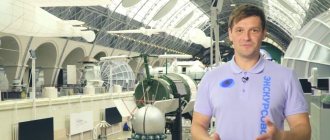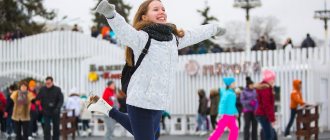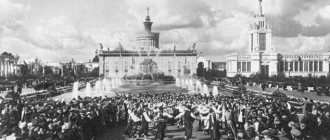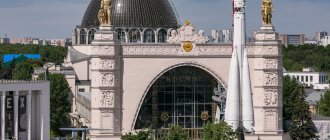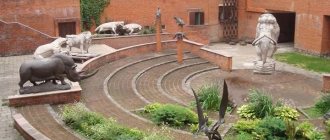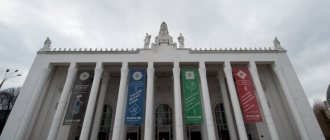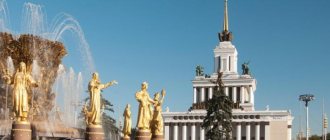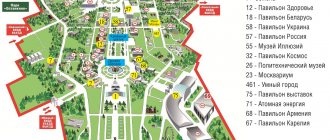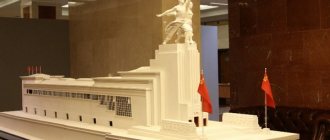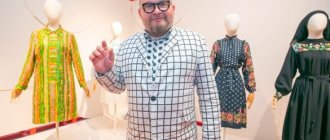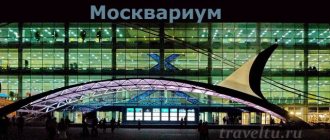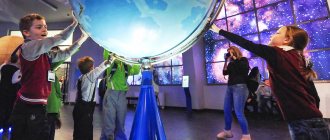Ensemble of the Alley of Cosmonauts
Where is this truly lovely corner located? Not far from one of the capital's most popular attractions - the Exhibition of Achievements of the National Economy, better known as VDNKh. It took a long time to choose the location for the monument. At first it was planned to place it on Vorobyovy Gory, where it would be as open as possible for viewing, but due to its gigantic size, it was decided to move the structure to VDNKh.
Many famous and little-known Soviet architects and engineers took part in the work on the main monument of the ensemble. More than three hundred and fifty projects were submitted to the commission.
You can get to the space ensemble by metro, reaching the VDNKh station of the same name. No matter which exit you come out from, you won’t pass by - you will find yourself either closer to the end of the alley or closer to its beginning.
We visit the Alley of Cosmonauts and walk around VDNKh
What is the pleasure of walking? An elegant Obelisk in honor of space exploration, which perfectly captures the swiftness of the take-off that heralds the opening of the era of space exploration. Monuments to famous cosmonauts and scientists, Museum of Cosmonautics. The impressive architecture of the All-Russian Exhibition Center pavilions, the International Exhibition of Flower Arrangements and Landscape Design, fountains, a real Yak-42 aircraft and a rocket.
Do you want to be the first to know about new interesting walks? Join our groups
In order to start our walk, we get to the VDNKh metro station and choose the exit “To VDNKh”. We leave the metro, look up... and see the Obelisk in honor of the exploration of outer space.
| At the bottom of the obelisk you can familiarize yourself with the main events related to the exploration of outer space. |
“1957. As a result of a lot of hard work by research institutes and design bureaus, the world's first artificial Earth satellite was created. On October 4, 1957, the first satellite was successfully launched.” (TASS report October 4, 1957)
“On April 12, 1961, the Soviet Union launched the world’s first spacecraft-satellite “Vostok” with a person on board.” (TASS report April 12, 1961)
We go out to the Alley of Cosmonauts. Along the alley there are monuments to cosmonauts and scientists: Gagarin, Glushko, Keldysh, Komarov, Leonov, Belyaev, Tereshkova. If you stand with your back to the stele, then on the right we will see a monument to the great Soviet scientist and constructor Sergei Pavlovich Korolev.
In the center of the alley is the Model of the Solar System.
At the end of the alley, near the “Conquerors of Space” stele, there is a monument to K.E. Tsialkovsky, behind which, in addition to the stele, is the Museum of Cosmonautics itself.
| If you move from the stella down the alley, then on the right between the trees you can see an interesting object - an AEROLIFT hot air balloon. You can complement your walk with an unforgettable experience of riding on such a miracle of progress... |
| We are moving towards the main gate of the Exhibition of National Economic Achievements. On the way, we pay attention to the monorail - the light metro line of Moscow. |
| Main gate of VDNKh | Ferris wheel |
To make it more interesting to walk around VDNKh, I suggest turning your gaze back 70 years and understanding where it all began...
“The history of the “Main Exhibition of the Country” began with the appeal of the Second All-Union Congress of Collective Farmers-Shock Workers to the central bodies of the Communist Party and government with a request to organize an All-Union Agricultural Exhibition in Moscow. The request was granted, and the Main Exhibition Committee was created.
To gain the right to participate in the All-Union Exhibition, collective farms, state farms, machine and tractor stations, scientific institutions had to have certain indicators for 1937 and 1938, and leaders and organizers of agriculture for 1938. Thanks to this condition, no agricultural exhibition in the world had such a number of exhibitors.” (official website of VDNKh https://www.vvcentre.ru/)
Today VDNKh is a wonderful holiday destination for Muscovites and guests of the capital.
In front of the main entrance of VDNKh there was previously a monumental composition “Worker and Collective Farm Woman”, which, according to some information, should soon be restored. While walking around the Exhibition of National Economic Achievements, you can ride horses or ride interesting bicycle cars that serve as taxis.
| VDNKh plan | Permanent exhibition “Moscow House of Butterflies” | Anniversary of the All-Russian Exhibition Center |
Every summer, the International Exhibition of Flower Arrangement and Landscape Design takes place on the territory of VDNKh. The exhibition is located along the main alley. Compositions of flowers and plants create a unique holiday atmosphere. It is especially wonderful to walk along the compositions on a sunny day.
In the main pavilion of VDNKh you can visit the Museum of Gifts of the television game “Field of Miracles”.
Walking around VDNKh, you will definitely appreciate the impressive architecture of most of the pavilions of the exhibition complex...
... you can ride a train to any point at VDNKh, rent rollerblades or a bicycle,...
…. and also buy honey or go to unusual exhibitions.
One of the symbols of VDNKh is the Fountain of Friendship of Peoples. It is also very interesting to see the real Yak-42 aircraft and missile located in the far part of the complex. Currently, the Yak-42 aircraft houses the Airplane gallery, which hosts exhibitions.
| If you are walking with children, they will be extremely happy to have an amusement park along the route... |
If after a walk around VDNKh you still have time and energy, you can explore the Church of the Tikhvin Icon of the Mother of God in Alekseevsky, the Ostankino Tower, the Ostankino estate, or take a walk in the Botanical Garden.
| Ostankino Tower | Botanical Garden | Church of the Tikhvin Icon of the Mother of God |
Print the walking route
central part
The center of the Alley of Cosmonauts in Moscow can conventionally be called a round platform on which cast-iron models of the planets of the solar system are located. Each layout is a separate object of study. Indeed, on their axes, in addition to the names, the most important scientific information about each planet is embossed. Unfortunately, in October 2021, the orbits of the planets were damaged by vandals. Large parts of them were stolen, apparently sold for precious metals.
All planets revolve, as expected, around the Sun. Here we can see Pluto, which was excluded from the planetary list. It should be noted that the location of the planets on this site corresponds to the moment when the first Earth satellite was launched.
How to get to VDNH
There are two ways to get to VDNKh:
Arrival at the metro station of the same name (VDNKh) , just a 15-minute drive from the center of Moscow. Coming out of this station, you can admire the size of the Cosmos Hotel. You can also get there by trolleybus.
- If you are going to visit the Museum of Cosmonautics and the monument to the Conquerors of Space, then after your visit you can go to VDNKh, the main entrance of which is located right next to this museum.
It is also important to know that there is a monorail that crosses part of the Ostankino district and crosses VDNKh. Its length is 4.7 km. It runs from the Ulitsa Sergei Eisenshteina station to the Timiryazevskaya station.
From one of the stops (Telecenter) you will immediately get to the Ostankino TV tower, which I will talk about later. This line is part of the Moscow Metro.
Find excursions around VDNH >>
Part up
The beginning of the Alley of Cosmonauts is flanked by two giant models of globes. One of them is a model of the globe with continents, islands, countries and their capitals, seas and oceans marked on the surface. Our megacities are also there - Moscow and St. Petersburg. Another layout is a celestial sphere, which depicts all the constellations.
Benches for visitors to this open-air museum are comfortably located along the wide paved alley on both sides, and in the center, at equal distances from each other, there are marble steles, topped with images of stars. In the stars are informational texts that briefly convey the essence of events taking place in the country in the field of space exploration and exploration. Many of them have the names of famous astronauts stamped on them. And the latter still do not have any text at all - as a symbol of the further development of astronautics, the events of which will someday take place in these voids.
"Golden Ear"
The “Golden Ear”, one of the three main fountains of VDNKh (along with the “Friendship of Peoples” and the “Stone Flower”), was also installed in 1954 - for the opening of the exhibition following the results of post-war reconstruction. It is located in the so-called dammed zone, in the center of pond No. 3, and is a 16-meter reinforced concrete structure in the form of a spike, covered with gold and red smalt of different shades.
66 jets emitted from nozzles located in the “grains” . Almost half of them reached 25 meters in height. At the end of the 1980s, the water supply system with which the structure was equipped failed, and the fountain was turned off. The Golden Ear has not worked for 30 years .
Background: Fountains of the main alley and the historical “Spike” were launched at VDNKh
And this summer, Muscovites and guests of the city can admire the revived and relaunched Golden Ear. In June, the scaffolding was removed and restorers returned the cleaned and restored fragments of the fountain's lining to their original places. In addition, its supporting structures were strengthened, utilities and pumping equipment were replaced, which made it possible to launch the most bizarre fountain of the exhibition for the first time in three decades.
a landscape park - is being completed at VDNKh . On the North Loop, not far from the bicycle rental pavilion No. 1, the symbols of the park—red and pedunculate oaks—rise. begins nearby . Its length is more than five kilometers. Linden trees were planted along the alley. 220 historical lighting poles create a cozy atmosphere for walking. Another 119 will be installed in the near future.
It is expected that after reconstruction, attendance at VDNKh will increase from 25 to 40 million people per year , and the tourist flow will increase by 25 percent.
Part after
At the site located closer to VDNKh, a rocket soars up from the Alley of Cosmonauts, taking off from a giant pedestal where the Museum of Cosmonautics is located underground. This is a monument to space explorers. Its facades are decorated with bas-reliefs on the theme of space research. Among the relief characters you can see representatives of all professions, thanks to which the conquest of space became possible. It was precisely because so many people took part in this work that the monument was named by the authors A.N. Kolchin and M.O. Barshchem "People-Creator". The monument was unveiled in 1964. Interestingly, the plume from the soaring rocket is lined with titanium panels.
In front of the museum building, closer to the central platform, on a high pedestal, there is a monument to the space genius of the Soviet era, Konstantin Eduardovich Tsiolkovsky. The image of Tsiolkovsky by Faydysh-Krandievsky is embodied in stone. His figure is made in a sitting position, his hands are folded on his knees, and his eyes are directed to the sky.
To the left of Tsiolkovsky, on a small area, there are monuments to scientists who made a huge contribution to the development of Cosmonautics: S.P. Korolev, M.V. Keldysh, V.N. Chelomey and V.P. Glushko.
Like Tsiolkovsky, Korolev, in his sculptural embodiment of the work of sculptors Shcherbakovs and architects Voskresensky and Kuzmin, stands peering into the sky, as if watching a rocket flying away at him. The high pedestal of the monument is decorated with reliefs on the theme of astronautics: the first steps in the conquest of space, the launch of the first satellite and the launch of the first rocket piloted by the first cosmonaut Yuri Gagarin, the first spacewalk performed by Alexei Leonov.
On the right along the facade of the Museum of Cosmonautics there are busts of Soviet cosmonauts, among which you can see: Yu.A. Gagarin, V.N. Tereshkova, P.I. Belyaev and A.A. Leonova, V.M. Komarova. And in 2016, several more busts appeared there: S. Savitskaya, V. Solovyov, A. Alexandrov and V. Lebedev.
Sculptures, monuments and busts on the Alley of Cosmonauts
Alley of Cosmonauts is practically an open-air sculpture museum!
The largest and most significant monument on it is the Monument to the Conquerors of Space, which was also the first of the monuments installed here: it was opened in 1964, and only 3 years later the Alley of Space Heroes appeared in front of it. The monument is made in the form of a giant 107-meter obelisk, lined with polished titanium plates, on top of which there is a rocket, and below it is the Memorial Museum of Cosmonautics.
The alley has a large number of monuments and busts to outstanding figures in astronautics: both the cosmonauts themselves and the designers and engineers. Among them:
• Yuri Gagarin - the first person to fly into outer space;
• Valentina Tereshkova - the first female cosmonaut;
• Pavel Belyaev is the first person to manually take a spacecraft out of orbit and land on Earth;
• Alexey Leonov - the first man in outer space;
• Vladimir Komarov - commander of the world's first spacecraft crew of 3 people;
• Valentin Glushko - one of the pioneers of rocket and space technology, the founder of Soviet liquid-propellant rocket engine construction;
• Mstislav Keldysh - a major scientific figure, one of the ideologists of the Soviet space program;
• Konstantin Tsiolkovsky - Russian and Soviet self-taught scientist, inventor, founder of theoretical astronautics, who justified the use of rockets for space flights;
• Sergei Korolev - “father of Soviet cosmonautics”, design engineer, prominent scientist and main organizer of the production of rocket and space technology and missile weapons in the USSR, founder of practical cosmonautics;
• Vladimir Chelomey is an outstanding designer of rocket and space technology, head of the development of a number of launch vehicles, artificial satellites and orbital stations, and one of the key creators of the Soviet “nuclear shield”.
Standing slightly apart is the sculptural composition with busts of Muscovite pilot-cosmonauts of the USSR, twice Heroes of the Soviet Union Alexander Alexandrov, Valentin Lebedev, Svetlana Savitskaya and Vladimir Solovyov.
In total, 14 monuments and busts to Russian cosmonauts, space engineers, scientists and designers were installed on the Alley of Cosmonauts.
In addition to monuments, decorative sculptures were also installed here. At the beginning of the alley there is a sculptural composition of 2 globes: the Earth and the Universe (with a map of constellations); The Earth globe marks the world's largest cities and engraves quotes from Konstantin Tsiolkovsky: “What is impossible today will become possible tomorrow” and “The Earth is the cradle of the mind, but you cannot live forever in the cradle.” In the central part there is a sculptural composition “Solar System”, depicting 9 planets (including Pluto) around the Sun, made in the form of a sundial.
Museum under the monument on Cosmonauts Alley in Moscow
In the basement of the monument to space explorers there is a Museum of Cosmonautics, rich in amazing exhibits telling about the origin and development of domestic space science and engineering.
Documentary and material sources of the most important information telling about the evolution of spacecraft, the first flights and the first cosmonauts, including the legendary Belka and Strelka, are carefully preserved here.
House-Museum of Sergei Korolev
A little further from the monument to the pioneers of outer space there is the Korolev Memorial House-Museum, where the designer lived until his death in 1966. The academician received the site in Ostankino by decision of the Council of Ministers of the USSR for the successful launch of the world's first artificial Earth satellite. The 2-story mansion, a typical example of Soviet functionalism, was built in 1959. As Korolev’s wife recalled, Sergei Pavlovich almost every evening, leaving the house for an evening walk, visited the construction site of the future monument to the Conquerors of Space.
The Korolev House-Museum is unique in many ways - the building has never been rebuilt; only the basement rooms, expanded to store exhibits, have undergone minor changes. The rooms contain the same furniture that was used during Korolev’s life, and there are about 19 thousand storage units on display and in closed collections. These are the designer’s personal belongings, documents, letters, photographs, household items, works of fine art, scientific, technical and art libraries.
Memorial house-museum of academician Sergei Korolev. Photo: Lori's photo bank
Photo: TASS
St. 1st Ostankinskaya, 28
View on map
+7
kosmo-museum.ru/mdmk
